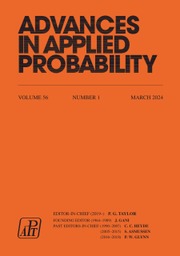No CrossRef data available.
Article contents
Limit laws for the generalized Zagreb indices of random graphs
Published online by Cambridge University Press: 26 May 2025
Abstract
In this paper, we study the asymptotic behavior of the generalized Zagreb indices of the classical Erdős–Rényi (ER) random graph G(n, p), as  $n\to\infty$. For any integer
$n\to\infty$. For any integer  $k\ge1$, we first give an expression for the kth-order generalized Zagreb index in terms of the number of star graphs of various sizes in any simple graph. The explicit formulas for the first two moments of the generalized Zagreb indices of an ER random graph are then obtained from this expression. Based on the asymptotic normality of the numbers of star graphs of various sizes, several joint limit laws are established for a finite number of generalized Zagreb indices with a phase transition for p in different regimes. Finally, we provide a necessary and sufficient condition for any single generalized Zagreb index of G(n, p) to be asymptotic normal.
$k\ge1$, we first give an expression for the kth-order generalized Zagreb index in terms of the number of star graphs of various sizes in any simple graph. The explicit formulas for the first two moments of the generalized Zagreb indices of an ER random graph are then obtained from this expression. Based on the asymptotic normality of the numbers of star graphs of various sizes, several joint limit laws are established for a finite number of generalized Zagreb indices with a phase transition for p in different regimes. Finally, we provide a necessary and sufficient condition for any single generalized Zagreb index of G(n, p) to be asymptotic normal.
MSC classification
Information
- Type
- Original Article
- Information
- Copyright
- © The Author(s), 2025. Published by Cambridge University Press on behalf of Applied Probability Trust


